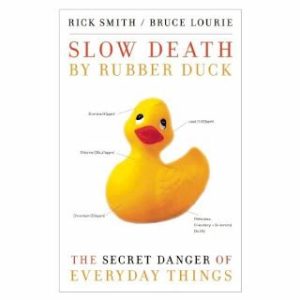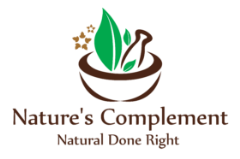
Book Review: Slow Death by Rubber Duck by Rick Smith & Bruce Lourie
This book needs to be read by anyone who cares about themselves, their family, their friends, and/or the planet. When you go to read this book, you need to have an open mind. An open mind to different definitions than what you are accustomed to. An open mind to look at words such as “pollution” from a completely different perspective. I did not start out with an open mind, and was quite reluctant to keep reading past the preface, but then I kept thinking about the following extremely important paragraph:
“There are 82,000 chemicals in use in the United States with 700 new ones added each year. Of these 82,000 some odd, only 650 are monitored through TRI, only 200 have ever been tested for toxicity, and only five have been banned under the Toxic Substances Control Act. Not even asbestos is banned, a known carcinogen that has killed nearly 45,000 Americans over the past 30 years.”
Shocking? I took this quote straight out of the preface of the book, which was copyrighted in 2009. (They have since published the updated and expanded version of the book, which I just ordered, but I’m scared to learn what the current numbers will be. Still, I can’t wait to read their expanded and updated version!)
I decided I wanted to know more, so I kept reading to see what the authors had to offer, and I must admit, I was quite surprised. This book was not at all what I expected it would be. Though an extremely important piece of research and writing none the less.
As a book about chemicals, this one is not your typical chemistry textbook type of book. It is enjoyable and is easy to read and follow, although painful when you read the reality of our exposures and what they do to us. The authors devote a chapter per chemical, and offer a large amount of researched information on the history, current usage, science, and lawsuits, etc., of each. I thought I was pretty savvy with my knowledge of many of the common chemicals, but by reading this book, I learned a deeper history behind the chemicals, and how their harmful effects were discovered. And also importantly, who tries to sweep the information under the rug, and why.
By no means is the information in the version I read perfect. For example, I question the wisdom of their four day period of self experimentation, but is sure gives one a good basis of how these chemicals can indeed get into our blood stream. I think I was more shocked to read that someone would willingly expose themselves to known harmful ingredients, although they make a good argument: people in general in our society expose themselves daily. I’m the (wise) “freak” who doesn’t even own any plastic Tupperware, and you will only find stainless steel, glass, and wood in my kitchen. If I can’t find it in organic I go without. I don’t even use aluminum foil.
There are some fallacies in the book. Such as implying that their only options for ketchup are organic in BPA lined plastic, or non-organic in glass. They don’t even offer the option of going to another store to look for a different brand of ketchup that offers both organic and a glass container; or better yet, just don’t eat ketchup, or make your own. But our culture often values flavor, convenience, and speed over health, and this was demonstrated a lot in this book.
Regardless, the poorly designed experiment and small fallacies of lifestyle are not what is important in the book. What’s truly important is the information they bring to light regarding the chemicals that are literally forced down our throats without our consent, on a daily basis.
And what about those most innocent in this struggle? Those that don’t get to choose what they wear or even eat. The ones developing in the womb and shortly after birth when their natural biological protections have yet to be developed in a young body? Where a parent gives their child a pacifier not realizing the toxins that can be sucked right out of the toy and into the babies developing brain and body? Or simple items around the home as the child crawls on all fours learning its way around the world, doing what it does naturally, putting their fingers in their mouth and learning their new world?
This book needs to be read by anyone who cares about themselves, their family, their friends, and the planet. Since we have only one planet. Oh, and this book only covers a few of the chemicals among the thousands that are out there. Only a few. A disturbing wealth of information that makes me want to run back to caveman days and hide in a cave. Unfortunately, the cave has probably been contaminated by PFOAs.
This book isn’t just about some random chemicals. It is a documentation of a terrible immoral scientific experiment performed on the public without our consent. As a scientist I wouldn’t even dignify this by calling it an “experiment”. It’s more like an ongoing chemical assault. But I have to give credit to the authors who willingly subjected themselves to being locked in a room with some of the chemicals they write about. While the experiments lacked positive/negative controls, and various other points usually needed for proper data sets, they did offer a glimpse into the reality that these chemicals do indeed get in your blood stream just by simply living a normal life.
I think I was fortunate to have grown up in a time where the connections between environment and health were already being made, so such concepts make complete sense to me. I have seen the direct result of what you put in your body (or even on your body), have a direct affect on your health. Just think of medications. We take a blood pressure pill, and that helps to lower our blood pressure, a direct result of a chemical that we put in our body, that has a result on our body. Or consider cortisone creams. You put them on your skin (outside the body), and it helps with whatever skin ailment, but many people can’t sleep if it’s put on at night, because the cortisone gets in their body affecting them. A perfect example of what goes on your body ends up in your body and has a direct affect on the body, systemically. So why wouldn’t toxic chemicals, some of which are known carcinogens, not affect your body? Because they’re not labeled as a medicine? Or because the big chemical producing companies try to sweep such information under the rug and hope you don’t do your own homework to discover how little they care about the health of you and your family.
And this book tells you just how much exposure is out there. Scary. And highly offensive.
Nature's Complement is a participant in the Amazon Services LLC Associates Program, an affiliate advertising program. If you purchase products on Amazon through any of our affiliate links, we get a small percentage of the transaction, at no extra cost to you. We spend a lot of time writing the articles on this site, and all this information is provided free of charge. When you use our affiliate links, you support the writing you enjoy without necessarily buying our products. (However we would appreciate if you would do that too!) Thank you for helping to support our work, however you choose to do so.
These statements have not been evaluated by the Food and Drug Administration. This information and/or products are not intended to diagnose, treat, cure or prevent any disease.


